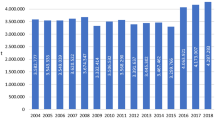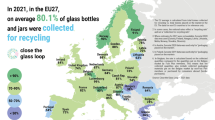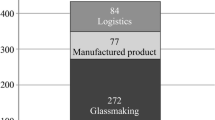A system for technological regulation of adverse environmental impacts (AEI) that is based on the best available technologies (BAT) was analyzed. The expediency of updating the informational and technical-reference guide to BAT Glass Production and the improvement of the precision of the technological indicators of resource and environmental efficiency of production are demonstrated. It is proposed that the secondary sources of AEI be regulated on the basis of general rules. It is emphasized that resource efficiency indicators should be used to calculate indicative indicators for carbon intensity that could find application in the regulation of greenhouse gas emissions by Russian industry.

Similar content being viewed by others
References
D. O. Skobelev, “Formation of the infrastructure of resource-technological transformation of industry,” Ékon. Ustoich. Razv., No. 1(41), 162 – 167 (2020).
T. V. Guseva, M. V. Begak, Ya. P. Molchanova, et al., “Prospects for adopting the best available technologies and moving to comprehensive environmental permits in the production of glass and ceramics (Review),” Glass Ceram., 71(7 – 8), 245 – 253 (2014) [Steklo Keram., No. 7, 26 – 36 (2014)].
ITS 5-2015. Information and Technical Guide to the Best Available Technologies ‘Glass Production’ [in Russian], URL: ITS 5-2015 Glass production, dated December 15, 2015 – docs.cntd.ru
S. V. Sekin, V. I. Litvin, and V. N. Tsevelev, “Choosing marker indicators in the course of preparing an information and technical guide on the best available technologies ‘Glass production’,” in: Best Available Technologies. Determination of Marker Substances inVarious Industries: Collection of Articles [in Russian], Pero, Moscow (2015), Art. 3, pp. 111 – 115.
Best Available Techniques (BAT): Reference Document for the Manufacture of Glass, European Commission, Joint Research Center, Institute for Prospective Technological Studies (2013), URL: https://eippcb.jrc.ec.europa.eu/sites/default/files/2019-11/GLS Adopted 03 2012 0.pdf (date accessed: 08.13.2021).
A List of Instructions of the President of the Russian Federation based on the Checking of the Implementation of the Provisions of the Legislation on the Management of Production and Consumption Waste Classified As Hazard Class III [in Russian], dated September 16, 2020 Pr-1489, paragraph 1b-1.
Methodology for Calculating the Releases (Emissions) of Pollutants into the Atmosphere During Welding (Based on Specific Indicators) [in Russian], NII Atmosfera, St. Petersburg (2015).
Methodology for Calculating the Releases (Emissions) of Pollutants into the Atmosphere When Applying Paint and Varnish Coatings (Based on Specific Indicators) [in Russian], NII Atmosfera, St. Petersburg (2015).
A. V. Kuleshov and O. I. Tikhonova, “Industrial environmental control as a tool for technological regulation of industry,” Standarty Kach-vo, No. 6, 68 – 72 (2021).
Guiding Principles of Effective Environmental Permitting Systems, OECD Guiding Document, OECD, Paris (2007), URL: https://www.oecd.org/env/outreach/37311624.pdf (date accessed: 08.13.2021).
E. V. Bragin, P. A. Makeenko, and T. V. Guseva, “On technological standards and other BAT conditions included in environmental permits (for the example of Great Britain),” in: The Best Available Technologies [in Russian], ASMS, Moscow (2017), pp. 99 – 123.
S. Yu. Daiman, T. V. Guseva, E. V. Zaika, and T. V. Sokornova, Management Systems: Practical Course [in Russian], Forum, Moscow (2010).
Federal Law “On Environmental Protection” Dated January 10, 2002, No. 7-FZ (as amended on December 30, 2020, with amendments and additions, entered into force on January 1, 2021) [in Russian], URL: https://legalacts.ru/doc/FZ-obohrane-okruzhajuwej-sredy/ (date of access: 08.13.2021).
M. V. Begak and T. V. Guseva, “Problems of environmental reform in Russia,” Vod. Khoz-vo Rossii: Probl., Tekhnol., Uprav., No. 5, 70 – 78 (2015).
Federal Law of 07.02.2021, No. 296-FZ “On Limiting Greenhouse Gas Emissions” [in Russian], URL: https://rg.ru/2021/07/07/fz-ob-ograni4enii-vybrosov-parnikovyh-gazov-dok.html (date accessed: 08.13.2021).
I. A. Bashmakov, V. I. Bashmakov, M. G. Dzedzichek, et al., CBAM. Consequences for the Russian Economy [in Russian], CENEF-XXI Century, Moscow (2021).
Commission Implementing Regulation (EU) 2021/447 of 12 March 2021 determining revised benchmark values for free allocation of emission allowances for the period from 2021 to 2025 pursuant to Article 10a (2) of Directive 2003/87/EC of the European Parliament and of the Council, URL: https://eur-lex.europa.eu/eli/reg impl/2021/447 (date accessed: 08.13.2021).
Author information
Authors and Affiliations
Corresponding author
Additional information
Translated from Steklo i Keramika, No. 10, pp. 18 – 23, October, 2021.
Rights and permissions
About this article
Cite this article
Guseva, T.V., Tikhonova, I.O., Tsevelev, V.N. et al. Optimization of Technological Regulation of Container Glass Production: Best Available Technologies, General Binding Rules, and Carbon Intensity of Products. Glass Ceram 78, 397–401 (2022). https://doi.org/10.1007/s10717-022-00419-y
Published:
Issue Date:
DOI: https://doi.org/10.1007/s10717-022-00419-y




